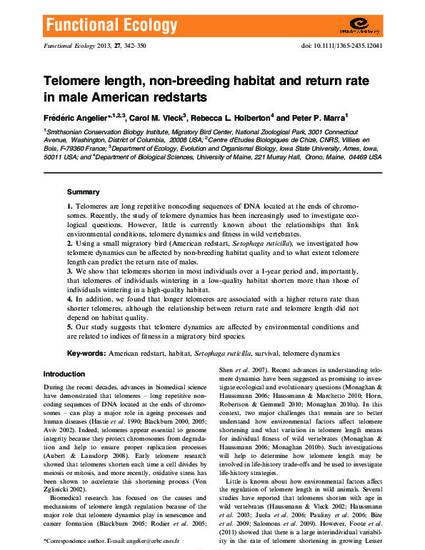
Article
Telomere length, non-breeding habitat and return rate in male American redstarts
Functional Ecology
Document Type
Article
Disciplines
Publication Version
Published Version
Publication Date
1-1-2013
DOI
10.1111/1365-2435.12041
Abstract
Telomeres are long repetitive noncoding sequences of DNA located at the ends of chromosomes. Recently, the study of telomere dynamics has been increasingly used to investigate ecological questions. However, little is currently known about the relationships that link environmental conditions, telomere dynamics and fitness in wild vertebrates. Using a small migratory bird (American redstart, Setophaga ruticilla), we investigated how telomere dynamics can be affected by non-breeding habitat quality and to what extent telomere length can predict the return rate of males. We show that telomeres shorten in most individuals over a 1-year period and, importantly, that telomeres of individuals wintering in a low-quality habitat shorten more than those of individuals wintering in a high-quality habitat. In addition, we found that longer telomeres are associated with a higher return rate than shorter telomeres, although the relationship between return rate and telomere length did not depend on habitat quality. Our study suggests that telomere dynamics are affected by environmental conditions and are related to indices of fitness in a migratory bird species.
Rights
Works produced by employees of the U.S. Government as part of their official duties are not copyrighted within the U.S. The content of this document is not copyrighted.
Language
en
File Format
application/pdf
Citation Information
Frederic Angelier, Carol M. Vleck, Rebecca L. Holberton and Peter P. Marra. "Telomere length, non-breeding habitat and return rate in male American redstarts" Functional Ecology Vol. 27 (2013) p. 342 - 350 Available at: http://works.bepress.com/carol-vleck/4/

This is a journal article from Functional Ecology 27 (2013): 342, doi:10.1111/1365-2435.12041. Posted with permission.